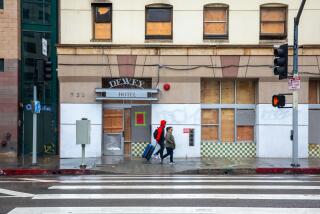Skid row’s homeless face more pressure as downtown L.A. grows
Once, not so long ago, Orlando Ward slept on L.A.’s skid row.
Strung out, he stretched out his 6-foot-7 frame on cardboard or newspaper on San Julian Street.
He knows that world. He still can summon up every awful bit of the long slide that landed him there. From Orange County basketball star and Stanford starter to career-ending knee injury and cocaine addiction. From shelter in a 12-year string of temporary spots — in corners of garages and on couches, in hospital beds and in jail cells — to no shelter at all, on hard sidewalk.
Ward got off the streets after 21/2 years in 1999, seeking help at the Midnight Mission. He ended up working for the mission, rising from kitchen duty to roles of greater responsibility — and voice.
As a result, the Orlando Ward of today, at 51, knows an alternate reality of Los Angeles’ movers and shakers. He’s well connected. He’s served on civic advisory committees and boards. As an advocate for those in need, first for the Midnight Mission, now for Volunteers of America, he’s taken the mayor around the very stretch of skid row on which he once figured he would die.
He knows just how different downtown Los Angeles can look depending on where you’re standing.
The other day, Ward and I walked a walk of extremes, taking in downtown from on high to down low. We started from the lush and leafy gardens of Walt Disney Concert Hall, where we talked about two very different worlds both growing at the same time.
Skid row lately has been skidding out again, more crowded, more filthy, more hopeless seeming. Meanwhile, much of the rest of downtown continues to spiff up, with new boutiques, new restaurants, ever more new visitors and residents.
High on Grand Avenue, we saw the bones of the future Broad museum taking shape. We saw the just-installed signs for Grand Park, connecting the Music Center to City Hall, which is due to open sometime this summer. We walked down the hill on 1st Street, through the courtyard of the new Los Angeles Police Department headquarters, past restaurants and loft buildings on Main Street.
One thing, Ward says, is obvious to him. When both ends of the spectrum, affluent and desperate, grow at the same time, they push against each other and pressure builds until, unless more is done, “you don’t have to be a physics major to know you’re going to have some kind of a combustible situation.”
Pressure has built for the skid row population, he says, as its presence has been tolerated in fewer and fewer places.
During the day, homeless downtown L.A., he said, has long known how to contain itself to a certain extent. But it used to be that at night, when the working world hit the freeways, people would spread out from skid row like watercolor on wet paper across the emptied-out streets and into Pershing Square, the civic center, the area now called the Old Bank District.
“Fifth and Main used to be ours,” he said. “We used to be able to go all the way east to the river before those new artists lofts people came there. We could go to 9th Street and 12th Street and all the way to the Holiday Inn by Staples. Now, best not go up to Staples. That territory is gone.”
So too is the way that tensions could diffuse for a bit as the skid row crowds “migrated to their neutral corners.”
No longer.
Ward isn’t entirely blaming the newcomers who have chosen to live downtown for wanting the place cleaned up a bit.
“The good-weather folks, they’ve gone back to Brentwood and West Hollywood and wherever the hell they came from,” he said. “But I believe there’s a core, the ones you see who’ve stayed put a long time, who believe in the viability of a walkable, livable, diverse, densely populated community.”
He stopped to chat for a few minutes at the doorway of the Rosslyn Lofts with a young man living there on disability in a very small and relatively low-cost micro-loft, who told him that working professionals also rent in the building, paying substantially more for larger and fancier lofts on higher floors.
That is living proof of a complex urban coexistence.
Still, Ward said, there’s growing power on one side of the equation — and he doesn’t think it’s always used for good.
Some relatively affluent newcomers, he said, are “not trying to understand the problem as much as get rid of it. They are buying a quality of life that says, ‘I’m going to go out on the street and I’m going to sit out at a cafe and I’m going to drink my green tea and I really don’t want to deal with somebody coming up and asking me for change.’”
You can’t just try to disappear it to skid row, and then forget what you no longer see, Ward said. That never works for long. The two worlds are too close.
As we headed east along 5th Street, past the small shops selling pinatas and umbrellas and studded belts and plastic pinwheels, we saw the blocks grow more and more peopled — groups sitting in clumps on the sidewalk, on curbs, bodies stretched out on the pavement, a lot of vague, checked-out eyes.
By the time we turned onto San Julian Street, every inch of sidewalk was staked out, and those vague eyes seemed to be everywhere.
So many people are working hard — to offer treatment for addictions, to try to house the chronically homeless. But so much more needs to be done, and everyone downtown needs to be shouting out for it in unison, he said.
We need to keep coming up with creative ideas to offer the right help to people when they’re ready for it — tailored to their own circumstances, he said. Help for a teen just tossed out of foster care can’t be the same as help for a newly homeless family. Someone just out of prison needs to be offered a bed off the street and not blocked from it because of a record.
More than anything, he said, we need to find ways to force communities outside of downtown to take responsibility for their own neediest, to offer housing and treatment options of their own so that all roads don’t end at skid row.
We also need to force ourselves to look.
Standing at street level on San Julian, you can see the tip tops of the skyscrapers.
From up on Grand Avenue you can’t see skid row at all. But it’s there, just a short walk away.
More to Read
Start your day right
Sign up for Essential California for news, features and recommendations from the L.A. Times and beyond in your inbox six days a week.
You may occasionally receive promotional content from the Los Angeles Times.







